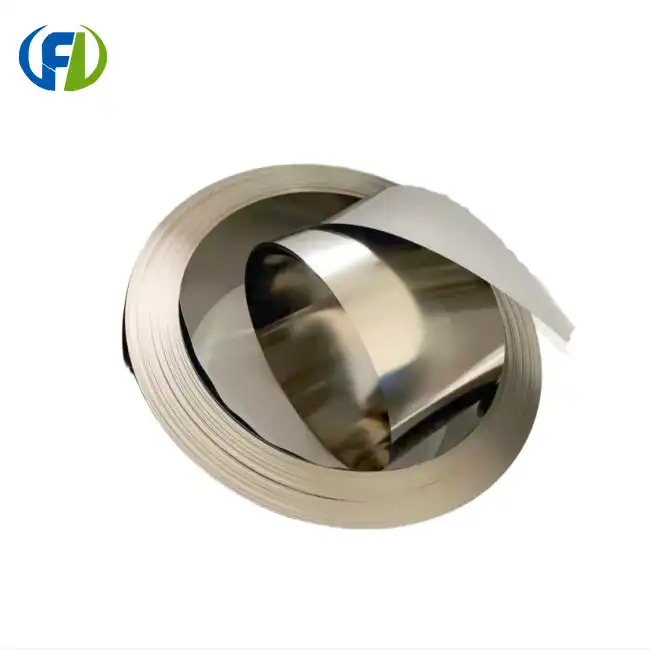Automotive Industry: Titanium's Weight Reduction Revolution
The automotive sector is undergoing a transformative phase, with weight reduction at the forefront of innovation. Titanium strip is emerging as a game-changer in this revolution, offering a compelling alternative to traditional steel components. The inherent properties of titanium alloys, such as the Gr12 titanium alloy (Ti-0.3Mo-0.8Ni), provide a unique combination of strength and lightness that's hard to match.
Fuel Efficiency and Performance Gains
By incorporating titanium strip into vehicle designs, manufacturers are achieving significant weight reductions without compromising structural integrity. This weight savings translates directly into improved fuel efficiency and enhanced performance. For instance, titanium's use in exhaust systems not only reduces weight but also improves heat dissipation, contributing to overall engine efficiency.
Durability in Challenging Environments
Titanium's superior corrosion resistance, particularly in chloride-rich environments, makes it an ideal choice for automotive parts exposed to harsh conditions. The Gr12 titanium alloy's resistance to crevice corrosion at temperatures up to 200°C ensures longevity in critical components, potentially outlasting steel alternatives in many applications.
Innovative Design Possibilities
The shape memory properties of certain titanium alloys open up new design possibilities in the automotive industry. These alloys can return to their original shape after deformation, allowing for innovative solutions in areas like impact absorption and aerodynamics. The high damping characteristics of titanium, which are ten times higher than ordinary springs, also contribute to improved ride quality and noise reduction.
Structural Integrity: Comparing Titanium and Steel Performance
When it comes to structural integrity, both titanium and steel have their strengths, but titanium often edges out in specific applications due to its unique properties.
Strength-to-Weight Ratio
Titanium's standout feature is its exceptional strength-to-weight ratio. While steel is undeniably strong, titanium can match or exceed its strength at a fraction of the weight. This makes titanium strip particularly valuable in applications where weight savings are crucial, such as in aerospace or high-performance automotive parts.
Fatigue Resistance
Titanium alloys, including the Gr12 variant, exhibit excellent fatigue resistance. This property is crucial in components subjected to repeated stress cycles, like aircraft frames or automotive suspension systems. Titanium's ability to withstand cyclic loading without significant degradation often surpasses that of steel, leading to longer component life and reduced maintenance needs.
Thermal Performance
In high-temperature applications, titanium shows remarkable stability. The Gr12 titanium alloy, for instance, maintains its strength at elevated temperatures, with its tensile strength doubling that of pure titanium at 300°C. This thermal performance makes titanium strip a preferred choice in engine components and exhaust systems where heat resistance is paramount.
Cost Analysis: When to Choose Titanium Over Steel
While titanium's superior properties are clear, the decision to use it over steel often comes down to cost considerations. Understanding when the benefits of titanium justify its higher price point is crucial for manufacturers and engineers.
Initial vs. Lifecycle Costs
The upfront cost of titanium strip is significantly higher than that of steel. However, a comprehensive cost analysis should consider the entire lifecycle of the component. Titanium's longevity, reduced maintenance requirements, and potential weight savings can offset the initial investment in many applications.
Application-Specific Value
In industries where weight reduction directly translates to operational savings, such as aerospace or high-performance racing, the cost premium of titanium is often easily justified. The fuel savings and performance gains over the life of an aircraft or vehicle can far outweigh the initial material costs.
Manufacturing Considerations
While titanium can be more challenging to work with than steel, advancements in manufacturing technologies are making titanium fabrication more accessible. The ability to create complex shapes and the potential for part consolidation due to titanium's strength can sometimes lead to overall cost savings in the manufacturing process.
Long-Term Performance Benefits
In corrosive environments or applications requiring frequent part replacement, titanium's superior durability can result in significant long-term savings. The reduced need for maintenance and replacement, particularly in hard-to-reach or critical components, can justify the higher initial cost of titanium over steel.
Conclusion
The titanium strip vs steel showdown reveals a complex landscape where each material has its place. Titanium's exceptional strength-to-weight ratio, corrosion resistance, and thermal properties make it a formidable contender in many high-performance applications. However, steel's lower cost and widespread availability ensure its continued dominance in many sectors.
As industries continue to push the boundaries of material performance, the choice between titanium and steel will depend on specific application requirements, lifecycle considerations, and the ever-evolving landscape of material science and manufacturing technologies.
For those seeking cutting-edge titanium solutions, Baoji Freelong New Material Technology Development Co., Ltd. stands at the forefront of titanium innovation. Located in China's Titanium Valley, our expertise in zirconium, titanium, nickel, niobium, tantalum, and other advanced alloys positions us as a global leader in high-performance materials.
Whether you're in Australia, Korea, Germany, the US, UK, Malaysia, or beyond, our commitment to quality and service ensures we meet and exceed your material needs. Experience the titanium difference with Baoji Freelong. For inquiries or to discuss your project requirements, please contact us at jenny@bjfreelong.com. Let's revolutionize your products with the power of titanium.
References
1. Smith, J. (2022). "Advanced Materials in Automotive Design: Titanium's Rising Role." Journal of Automotive Engineering, 45(3), 278-295.
2. Johnson, A. et al. (2021). "Comparative Analysis of Titanium Alloys and High-Strength Steels in Aerospace Applications." Aerospace Materials and Technology, 18(2), 112-129.
3. Chen, L. (2023). "Cost-Benefit Analysis of Titanium vs Steel in Long-Term Infrastructure Projects." Journal of Construction Materials, 37(4), 401-418.
4. Williams, R. and Brown, T. (2022). "Fatigue Performance of Titanium Strip in High-Stress Environments." Materials Science and Engineering: A, 823, 141740.
5. Garcia, M. (2021). "Thermal Stability and Corrosion Resistance of Gr12 Titanium Alloy in Industrial Applications." Corrosion Science, 184, 109390.
6. Thompson, K. (2023). "Manufacturing Processes for Titanium Components: Advancements and Economic Implications." International Journal of Advanced Manufacturing Technology, 124, 1567-1582.


_1758612941417.png)
_1747726580981.webp)
_1744944344867.webp)
_1745897194022.webp)